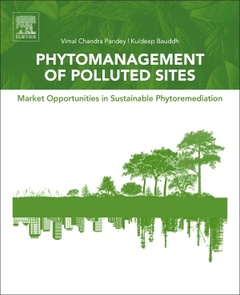Phytomanagement of Polluted Sites Market Opportunities in Sustainable Phytoremediation
Coordonnateurs : Pandey Vimal Chandra, Bauddh Kuldeep

Phytomanagement of Polluted Sites: Market Opportunities in Sustainable Phytoremediation brings together recent and established knowledge on different aspects of phytoremediation, providing this information in a single source that offers a cutting-edge synthesis of scientific and experiential knowledge on industrially contaminated site restoration that is useful for both practitioners and scientists. The book gives interested groups, both non-profit and for-profit, methods to manage dumpsites and other contaminated areas, including tactics on how to mitigate costs and even profit from ecological restoration.
1. Phytoremediation: From theory towards practices 2. Market opportunities in sustainable phytoremediation 3. Ecological Restoration of Coal Mine Degraded Lands – Topsoil Management, Pedogenesis, Carbon Sequestration and Mine Pit Limnology 4. Ecorestoration of fly ash deposits by native plant species at thermal power stations (Serbia) 5. Ecorestoration of polluted aquatic ecosystems through rhizofiltration 6. Floral species in pollution remediation and augmentation of micrometeorological conditions and microclimate: An integrated approach 7. Phytoremediation of Air Pollutants: Prospects and Challenges 8. A review of phytoremediation prospects of arsenic contaminated water and soil 9. Aromatic crops in phytoremediation: From contaminated to waste dump sites 10. Rehabilitation of uranium contaminated sites by phytoremediation and natural attenuation 11. A sustainable phytoremediation strategies for river water rejuvenation 12. Restoration of pesticide contaminated sites through plants 13. Adaption mechanisms in plants under heavy metal stress conditions during phytoremediation 14. Application of soil quality indicators for phytorestoration of mine spoil 15. Rhizoremediation of polluted sites: harnessing plant-microbe interactions 16. Phytoremediation of red mud deposits through natural succession 17. Eco-restoration potential of vegetation for contaminated water bodies 18. Phytomanagement of chromium contaminated brown fields 19. Techno-economics perspectives of bioremediation of wastewater, dewatering and biofuel production from microalgae 20. Exploring the potential and opportunities of recent tools for removal of hazardous materials from environments 21. Recent advances, challenges and opportunities in bioremediation of hazardous materials 22. Economics, Technology and Environmental Protection: A Critical Analysis of Phytomanagement Technologies
researchers in Environmental Science, Environmental Managers
- Covers successful examples of turning industrially contaminated sites into ecologically healthy revenue producers
- Explores examples of phytomanagement of dumpsites from around the globe
- Provides the tools the reader needs to select specific plant species according to site specificity
Date de parution : 12-2018
Ouvrage de 626 p.
19x23.3 cm
Thèmes de Phytomanagement of Polluted Sites :
Mots-clés :
Adaptation; Aerosols; Anthropogenic forcing; Aquatic ecosystem; Aquatic plants; Arabidopsis halleri; Aromatic crops; Arsenic; Bio-fertilizer; Bioaccumulation; Biodiversity; Biodiversity assessment; Bioengineering; Biofuel; Biofuels; Bioleaching; Biomass; Bioremediation; Biosorption; Carbon sequestration; Chromium; Climate change; Coal mining; Constructed wetland; Contaminants; Contaminated sites; Decontamination methods; Eco-restoration; Ecophysiological potential; Ecorestoration; Emerging contaminants; Fly ash; Food versus fuel; Green technology; Harvesting; Hazards; Heavy metals; High value-added crops; Hyperaccumulator; Hyperaccumulator plants; Hyperaccumulators; Hytoextraction; Hytofiltration; ILUC; India; Indigenous peoples; Indoor air; Land surface processes; Market opportunities; Metabolic engineering; Microalgae; Microbes; Micrometeorological parameters; Mine land; Mine soil; Mine spoil; Molecular biology; Native plants; Natural succession; Nature-based solutions; Pesticide; Phytodegradation; Phytodiversity; Phytomanagement; Phytoremediation; Phytoremediation strategies; Phytorestoration; Phytostabilization; Phytostabilization phytotechnologies; Pollutants; Pollution; Post-genomic era; Pretreatment; Reclamation; Red mud; Rhizofiltration; Rhizoremediation; Sensor; Soil; Soil quality index; Soil quality indicators; Sown native plants; Spontaneous native colonizers; Succession; Surface coal mining; Sustainable development; Sustainable phytoremediation; Synthetic biology; Tannery; Technology; Terrestrial plants; Thlaspi caerulescens; Toxic metals; Toxicity; Translocation; Uptake mechanisms; Volatile organic compounds; Waste dumpsites; Wastewater; Wastewater treatment



